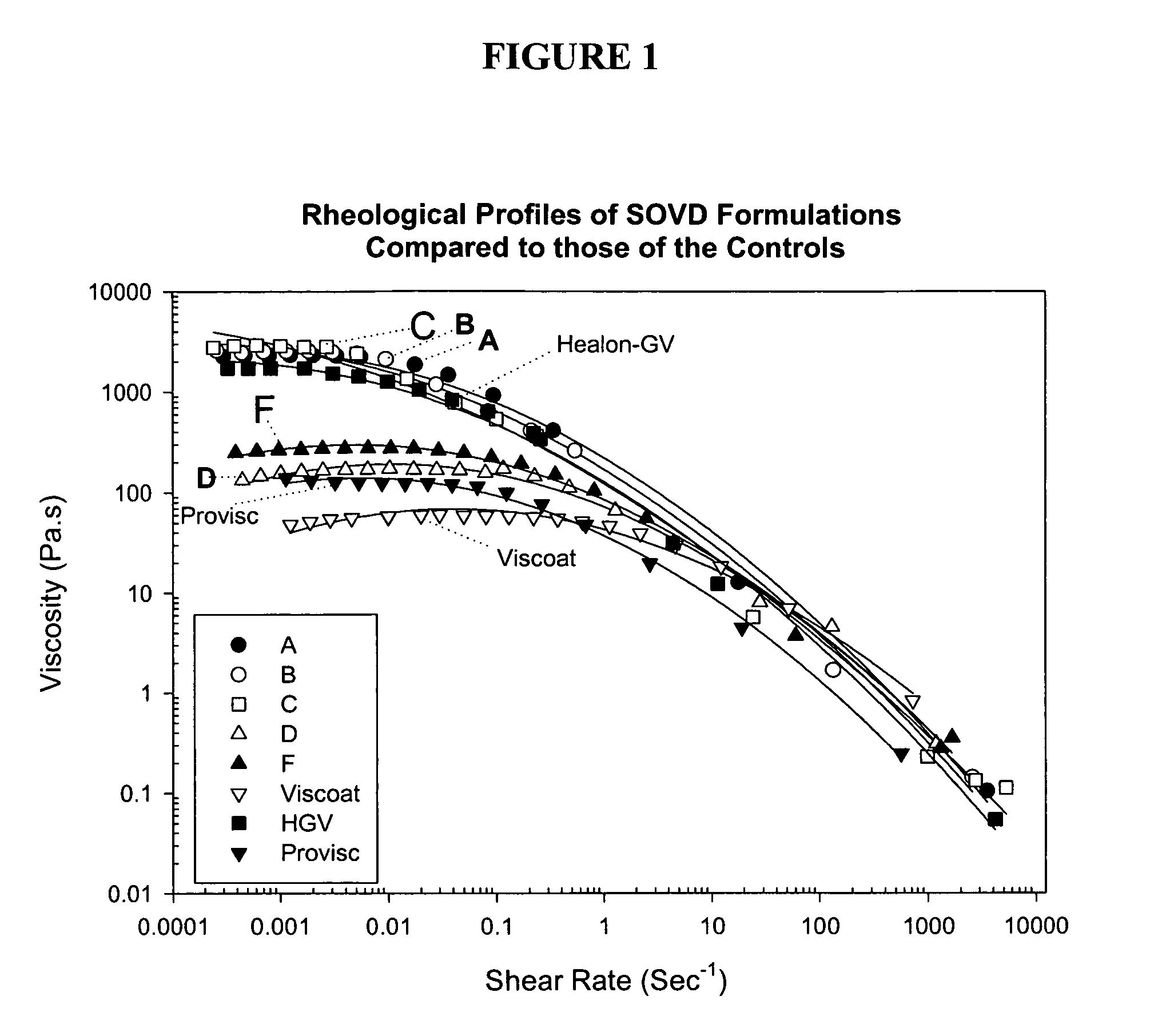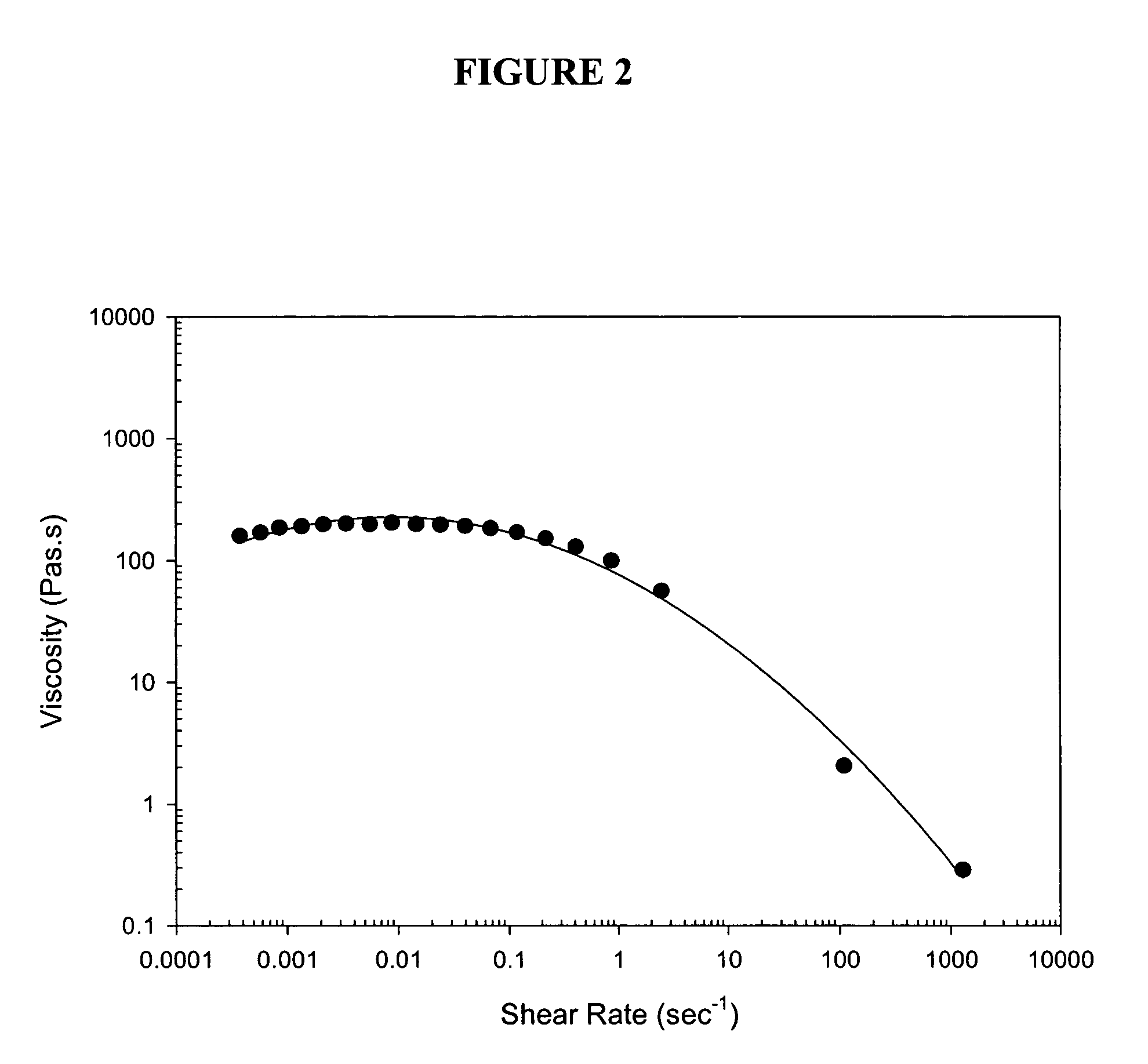Combinations of viscoelastics for use during surgery
a technology of viscoelastics and ocular tissue, which is applied in the field of new combination of viscoelastic agents, can solve the problems of not being able to best meet all surgical purposes, no one viscoelastic agent best meets all surgical purposes, and the anterior chamber of the eye is more difficult to remove than some other agents, so as to improve rheology, improve rheology, and facilitate the manipulation of ocular tissues.
- Summary
- Abstract
- Description
- Claims
- Application Information
AI Technical Summary
Benefits of technology
Problems solved by technology
Method used
Image
Examples
example 1
Viscoelastic Preparation
[0018]A. HA raw material (sodium hyaluronate) was obtained sterile.
[0019]B. CS raw material (sodium chondroitin sulfate) was obtained non-sterile. CS was fully hydrated in buffer and sterile filtered through a 0.2μ filter.
[0020]C. Sterile HA raw material was hydrated in the sterile CS / buffer solution following an following an aseptic process while mixing in two syringes connected via a Luer-Lok connector.
[0021]D. After proper mixing and over-night hydration, a sterile clear viscous solution was obtained which was stored in refrigerator for complete de-aeration.
[0022]E. The viscous solution was then filtered through a 4.5μ filter under 50 psi pressure to yield essentially particulate-free, clear solution.
example 2
[0023]
TABLE 1FORMULATONS EVALUATEDSOVDCompositionLabelHMW HA1.6% HMWHA + 1% CSA(2.2 md)1.6% HMWHA + 2% CSB1.6% HMWHA + 4% CSCMMW HA1.8% MMWHA + 1% CSD(1.6-1.8 md)1.8% MMWHA + 4% CSF1.7% MMWHA + 4% CSGViscoat 3% HA + 4% CSHHealon-GV1.4% HMWHAIHMW = high molecular weightMMW = medium molecular weightmd = million daltons
[0024]Rheological profiles of one preferred embodiment (Formula F) and other formulations tested, including marketed viscoelastic products, are shown in FIG. 1. From FIG. 1 it is apparent that the viscosity of Formula F falls uniquely between that of Provisc and of Healon GV at low shear rates, but surprisingly falls between that of Viscoat and of Provisc at high shear rates. A rheological profile of another preferred embodiment (Formula G) is shown in FIG. 2. As can be seen from FIG. 2, the viscosity of Formula G has similar characteristics to that of Formula F relative to the marketed viscoelastic products.
example 3
[0025]Table 2 presents zero shear viscosity data for the formulation G and other formulations compared to those of the marketed viscoelastic products.
[0026]
TABLE 2ZERO SHEAR VISCOSITYFormulationZero Shear ViscosityLabel(Pa · s.)A2300B2600C2900D170F280G250Viscoat60Provisc150Healon-GV1500
[0027]Consistent with the data presented in FIGS. 1 and 2, the zero shear viscosities of the medium molecular weight HA formulations of the present invention (D, F and G) are greater than the zero shear viscosities of Viscoat and Provisc, but significantly less than that of Healon-GV. Further, in terms of the Food and Drug Administration accepted viscosity measurement standard, the preferred embodiment of the present invention presented as Formula G is formulated to a viscosity of 75±35 Pa·s at a shear rate of 1 sec−1 at 25° C.
PUM
| Property | Measurement | Unit |
|---|---|---|
| molecular weight | aaaaa | aaaaa |
| zero shear viscosity | aaaaa | aaaaa |
| molecular weight | aaaaa | aaaaa |
Abstract
Description
Claims
Application Information
 Login to View More
Login to View More - R&D
- Intellectual Property
- Life Sciences
- Materials
- Tech Scout
- Unparalleled Data Quality
- Higher Quality Content
- 60% Fewer Hallucinations
Browse by: Latest US Patents, China's latest patents, Technical Efficacy Thesaurus, Application Domain, Technology Topic, Popular Technical Reports.
© 2025 PatSnap. All rights reserved.Legal|Privacy policy|Modern Slavery Act Transparency Statement|Sitemap|About US| Contact US: help@patsnap.com



